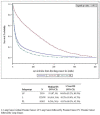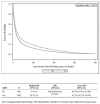Concurrent Androgen Deprivation Therapy for Prostate Cancer Improves Survival for Synchronous or Metachronous Non-Small Cell Lung Cancer: A SEER-Medicare Database Analysis
- PMID: 35804979
- PMCID: PMC9265064
- DOI: 10.3390/cancers14133206
Concurrent Androgen Deprivation Therapy for Prostate Cancer Improves Survival for Synchronous or Metachronous Non-Small Cell Lung Cancer: A SEER-Medicare Database Analysis
Abstract
Introduction: The crosstalk between receptor kinase signaling, such as EGFR and androgen receptor signaling, suggests a potential interaction between androgen deprivation therapy (ADT) and lung cancer outcome. Methods: We employed the SEER−Medicare data of lung cancer patients diagnosed between 1988 and 2005 to test for an association between ADT for prostate cancer and lung cancer outcome. We employed the Kaplan−Meier method and Cox proportional hazard with log-rank test model to assess any significant impact of ADT on survival. Results: We included data from 367,750 lung cancer patients; 17.4%, 2.9%, 33.6% and 46.1% with stages I, II, III and IV, respectively; 84.5% were >65 years; 57.2% males; 84.2% Caucasians and 9.3% Blacks. There were 11,061 patients (3%) with an initial prostate cancer diagnosis followed by lung cancer (P-L group); 3017 (0.8%) with an initial diagnosis of lung cancer and subsequent prostate cancer diagnosis (L-P group); the remainder had only lung cancer (L group). Stage I lung cancer was most common in the L-P group compared to the L and P-L groups—54% vs. 17.13% vs. 17.92%, p < 0.0001 for L-P, L and P-L, respectively. The median OS for lung cancer diagnosis was 93 months versus 10 and 9 months, respectively, for the L-P, L and P-L subgroups. ADT was associated with improved survival on multivariate analysis, especially in Caucasian patients (HR of death: 0.86; 95% CI: 0.76−0.97; p = 0.012). Conclusion: ADT was associated with improved outcome for NSCLC, in line with the hypothesis of a role for the androgen receptor in lung cancer. Our findings support a systematic evaluation of the potential benefit of ADT as a therapy for lung cancer.
Keywords: SEER; androgen deprivation therapy; hormonal therapy; lung cancer; prostate cancer.
Conflict of interest statement
B.N. reports a paid advisory board role for Exelixis and was a paid participant in a case discussion for IntrinsiQ Specialty Solutions—AmerisourceBergen. T.K.O. reports a paid advisory board role for BMS, AstraZeneca and Merck, and a paid consultancy (data monitoring board) for Roche/Genentech and EMD Serono. All other authors have no conflicts of interest to disclose.
Figures
Similar articles
-
Androgen deprivation therapy plus docetaxel and estramustine versus androgen deprivation therapy alone for high-risk localised prostate cancer (GETUG 12): a phase 3 randomised controlled trial.Lancet Oncol. 2015 Jul;16(7):787-94. doi: 10.1016/S1470-2045(15)00011-X. Epub 2015 May 28. Lancet Oncol. 2015. PMID: 26028518 Clinical Trial.
-
The need for androgen deprivation therapy in patients with intermediate-risk prostate cancer treated with dose-escalated external beam radiation therapy.Can J Urol. 2017 Feb;24(1):8656-8662. Can J Urol. 2017. PMID: 28263132
-
Improved Survival With Prostate Radiation in Addition to Androgen Deprivation Therapy for Men With Newly Diagnosed Metastatic Prostate Cancer.J Clin Oncol. 2016 Aug 20;34(24):2835-42. doi: 10.1200/JCO.2016.67.4788. Epub 2016 Jun 20. J Clin Oncol. 2016. PMID: 27325855
-
Intermittent androgen deprivation therapy in advanced prostate cancer.Curr Treat Options Oncol. 2014 Mar;15(1):127-36. doi: 10.1007/s11864-013-0272-2. Curr Treat Options Oncol. 2014. PMID: 24395278 Review.
-
American Brachytherapy Society Task Group Report: Use of androgen deprivation therapy with prostate brachytherapy-A systematic literature review.Brachytherapy. 2017 Mar-Apr;16(2):245-265. doi: 10.1016/j.brachy.2016.11.017. Epub 2017 Jan 16. Brachytherapy. 2017. PMID: 28110898 Free PMC article. Review.
Cited by
-
Role of sex and sex hormones in PD-L1 expression in NSCLC: clinical and therapeutic implications.Front Oncol. 2023 Oct 24;13:1210297. doi: 10.3389/fonc.2023.1210297. eCollection 2023. Front Oncol. 2023. PMID: 37941543 Free PMC article. Review.
-
New Perspectives on Sex Steroid Hormones Signaling in Cancer-Associated Fibroblasts of Non-Small Cell Lung Cancer.Cancers (Basel). 2023 Jul 14;15(14):3620. doi: 10.3390/cancers15143620. Cancers (Basel). 2023. PMID: 37509283 Free PMC article. Review.
-
Stranger Things: New Roles and Opportunities for Androgen Receptor in Oncology Beyond Prostate Cancer.Endocrinology. 2023 Apr 17;164(6):bqad071. doi: 10.1210/endocr/bqad071. Endocrinology. 2023. PMID: 37154098 Free PMC article. Review.
-
Unveiling the Potential of S4 on Non-small Cell Lung Cancer Cells: Impact on Proliferation, Apoptosis, Senescence, and Metabolome Profile.Anticancer Agents Med Chem. 2025;25(11):785-799. doi: 10.2174/0118715206350735241224073200. Anticancer Agents Med Chem. 2025. PMID: 39844407
References
-
- American Cancer Society Key Statistics for Lung Cancer. 2019. [(accessed on 10 July 2020)]. Available online: https://www.cancer.org/cancer/lung-cancer/about/key-statistics.html.
-
- Torre L.A., Siegel R.L., Jemal A. Lung Cancer and Personalized Medicine. Springer; Berlin/Heidelberg, Germany: 2016. Lung cancer statistics; pp. 1–19. - PubMed
LinkOut - more resources
Full Text Sources
Research Materials
Miscellaneous



